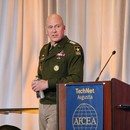What’s Next for the Army’s Unified Network?
The exercise Morrison detailed shows that the Army has mostly addressed its institutional hurdles to bringing its echelons together under a coherent operational architecture.
“The network is becoming a weapon system,” Morrison said.
Next, G-6 — which implements command, control, communications, cybersecurity operations and networks for the Army’s global operations — needs to reorganize its divisional force structure. That means if 90% of the Army’s patching tasks can be done from one location, local cyber defenders can be repurposed to units, Morrison said.
This restructuring ensures the Army will have technical expertise where it’s needed, though it will require additional training for internal personnel and civilian teammates.
“If it’s truly a unified network, everybody has got to be trained to the same level,” Morrison said.
DISCOVER: The Army turned to industry to secure its remote classrooms.
G-6’s deputy chief of staff also wants to see cyber defenders’ analytical workloads lightened through automation, as well as greater integration of operating pictures from the edge. Those two aspects of the unified network are where industry comes in, Morrison said.
The Army simply can’t develop IT capabilities like vendors can, so vendors must put a “military wrapper” around their solutions, Morrison said.
“We don’t have any brigades within our Army that are completely interoperable within themselves,” Morrison said.
That’s a problem when all the Army wants brigade combat teams doing is maneuvering and fighting, with the task of prosecuting those fights moving up to the division, corps and theater levels, he added.














